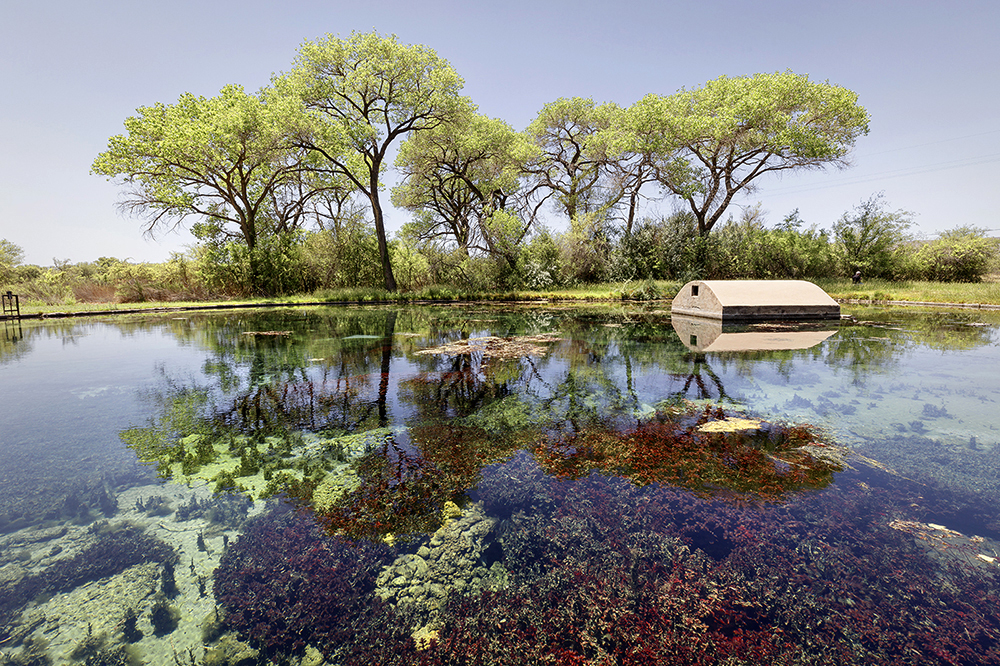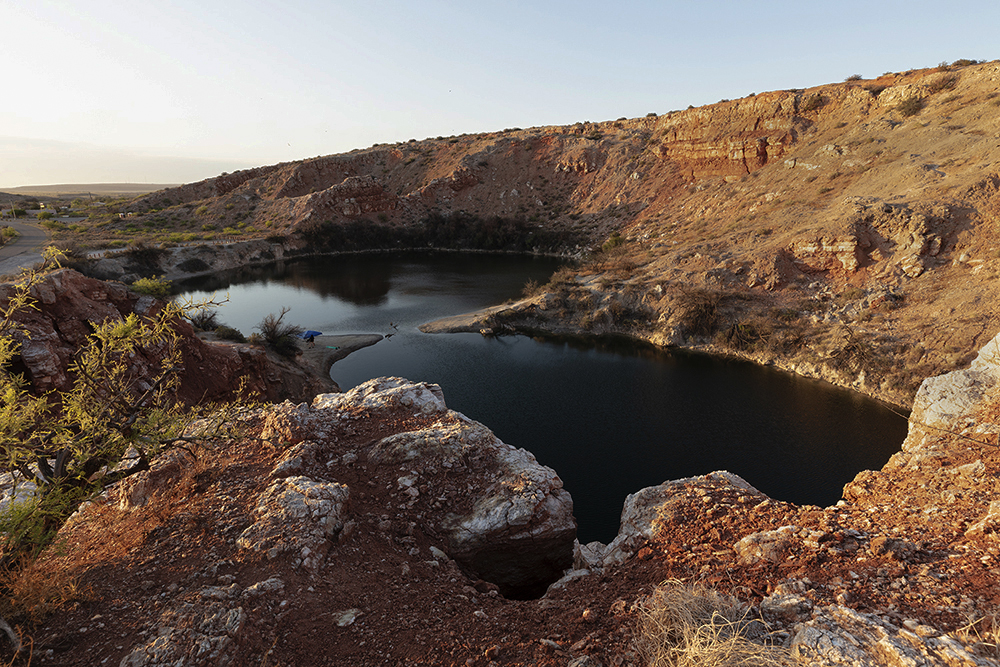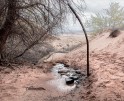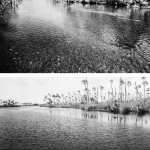Bremner Benedict: Art + Science Award – Honorable Mention

©Bremner Benedict 2021, Unnamed Spring, Moenave Road, Colorado Plateau, AZ Petroglyphs in the area suggest this was a dependable source of water for ancient peoples as well as present day Navajo and Hopi Native Americans. In the 1880’s this was a favorite stop on the pioneer Mormon Honeymoon Trail
In the Lenscratch call Art + Science Award: The Heart of the Matter, we asked photographers to consider a shifting perspective of our current world, placing emphasis on the most pertinent themes that reside throughout the boundaries of art and science. Due to the superlative quality of the submissions, it was challenging to narrow down from 137 portfolios to seven final selections.
This week in Lenscratch, we look at the seven winning artists who use photography to investigate themes emphasizing the impact of emotional, physiological and environmental forces upon individuals and societies. Some projects shed light on dualities like beauty and fear or human rights and authority, while others resonate with a singular vision
In a broad sense, each of the winning artists submitted a series of photographs that makes the invisible visible. From the questioned intentions surrounding surveillance to the exposure of transitioning fungi, these works share interwoven threads with the current frenetic stillness of our world.
Linda Alterwitz and Patrick C. Duffy

©Bremner Benedict 2021, Bog Hot Springs, Great Basin Desert, NV Originally dredged to divert water to local ranches, these springs continue to be ‘mined’ for their water. Northern Nevada hot springs spas were once popular tourist destinations valued for their healing waters. Their popularity waned in the 1930’s. None of them remain.
Bremner Benedict is a photographer based in West Concord, MA and Tucson, AZ. Her work addresses the shifting connections that humans have with landscape and the impact we are causing within the natural environment. In her ongoing series, Hidden Waters: Dryland Springs in the West, Benedict continues to document desert springs within the American West and Northern Mexico. She begins with extensive research, studying maps of where springs are marked, recording their GPS coordinates, and driving to these locations. Her photographs document the current conditions and predicaments of springs, from unaltered, restored, heavily altered, destroyed, to drained dry. There is a quiet beauty to this work, offering awareness to the delicate nature of our planet’s ecosystems and our need to protect our natural resources.

3. ©Bremner Benedict 2021, Big Hollow Spring, Colorado Plateau, UT When their waters are diverted into livestock watering tanks the springs’ ecosystems lose their biodiversity.

©Bremner Benedict 2021, Longstreet Springs, Mojave Desert, NV This spring is part of the last intact oasis in the Death Valley area. The springs’ waters were so diverted for industrial production, it almost destroyed them. They were purchased in the 1980’s by the Nature Conservancy who donated them to the Ash Meadows National Wildlife Refuge for their restoration and protection.
Beautiful, damaged or gone, arid-land springs an unseen detail in the American West, are disappearing. Although freshwater springs have been essential to our survival for millennia, a staggering 80% of those have been destroyed by climate change and overuse since 1900, and that rate is only increasing. To interpret the unique role of natural springs in the human and natural world, I’m inspired by Western landscape painter, Maynard Dixon in the way I use light and color to envision their vulnerability in the face of climate change and aquifer depletion. As blend of art and science, this series questions whether the unnoticed parts of the natural world hold an important truth about our experience we overlook While currently, the West is the driest it has been in 1,200 years, springs still hold vital clues to the health and longevity of the underground aquifers we all depend on. Currently, there is a lack of public information on the importance of these waters and the need for their protection. Conservation is inconsistent at best. The goal of this work is to create an important historical record of keystone ecosystems before they are lost forever and to inspire thought and dialogue about what value we place on the natural world, since loss of these biologically diverse, ecologically significant, and culturally important ecosystems could threaten our survival as well.

©Bremner Benedict 2021, Pinto East Hot Springs, Black Rock Desert, Great Basin, NV Used by indigenous Shoshone and Paiute Native Americans for over 6,000 years, contemporary scientists search these hyper-saline, extremely hot waters for new medicinal compounds while geo-thermal companies in the area consider exploiting them for energy use.

©Bremner Benedict 2021, MC Springs, Mojave Desert, CA Named for the Mojave Chub and endangered desert fish found only in the Mojave River, this spring was a water stop on the arduous “Old Spanish Trail” which the Spanish and later pioneers walked from Santa Fe, NM to California.

©Bremner Benedict 2021, Ink Well, Chihuahuan Desert, NM This deep-water cenote or sinkhole fed by underground springs is one of a string of nine lakes. They were formed from an ancient limestone reef which eroded leaving collapsed caves which later filled with water.

©Bremner Benedict 2021, Agua Caliente, Sonoran Desert, Az Visited since 4,000 BCE, alterations, overuse, severe drought combined to lower the water table, depleting this once vital spring. Today its nearby ponds rely mainly on water restoration by the city.

©Bremner Benedict 2021, Quitovac Springs, Sonoran Desert, Mexico These springs are on the Tohono O’odham tribe’s salt trail. They are one of their most sacred sites. Their lands once stretched from south-central Arizona deep into northern Sonora. They are constantly under threat from private business interests.

©Bremner Benedict 2021, Rattlesnake Springs, Chihuahuan Desert, NM From pre-Columbian peoples to Mescalero Apaches, to WWII pilots from a nearby military base, these waters have survived through history and remain important as a stop-over on the Central Migratory Flyway for hundreds of birds on their yearly North/South migrations.

©Bremner Benedict 2021, Pat Tub #1, Colorado Plateau, Az The spring waters are stored in this giant tub to be used for livestock watering and fire suppression.

©Bremner Benedict 2021, Crystal Springs Reservoir, Mojave Desert, NV Mammoths drank from these waters which collected as rainwater during the last Ice Age. “Fossil” or “Paleo” water can travel long distances and take thousands of years to come to the surface. Mammoths drank from these springs where Recognized as internationally important wetlands possessing significant value to humanity, this largest intact oasis in Death Valley is a biodiversity ‘hot spot’ and the sole habitat for approximately 25 unique and endemic plants and animals.

©Bremner Benedict 2021, Liston Seep, Colorado Plateau, UT This small seep is on the Hole-in-the-Rock road from Escalante, Utah. The road was made in the 1880’s for Mormon pioneers trying to cross the Colorado River in Glen Canyon. When isolated springs are diverted like these, the surrounding land dries out diminishing biodiversity.

©Bremner Benedict 2021, Dyke Hot Springs, Black Rock Desert, Great Basin, NV Alteration of springs even for recreational use can severely disturb springs ecosystems. A desert spring can be the only water source for miles altering it can have widespread unintended on plant and animal biodiversity.

©Bremner Benedict 2021, Mirror Lakes, Chihuahuan Desert, NM When the water is very high these two nearly circular lakes join making one large lake. Irrigation in the Pecos Valley has lowered the water table, so the two rarely join to form a single lake anymore.
Benedict’s projects center on the role that landscape plays in the human experience and explores the difficult truth of what we lose as a result of what we choose to ignore in the natural world. In 2015, Benedict began Hidden Waters, a series that combines art and science to focus on natural springs in the American West, with the intention of establishing an important historical record of these endangered places before they are lost. Recent awards include Conversations with The Land, Juror’s Award, Center for Fine Art Photography, 2021, Massachusetts Cultural Council Finalist, 2021; Critical Mass Top 200, 2019; Juror’s Honorable Mention, 2021, Art and Science 2, A. Smith Gallery 2021; the FENCE, New England, 2019; Legacy Award, Griffin Museum of Photography; two Puffin Foundation Grants; and Museum of Northern Arizona artist residency. Hidden Waters is in the archives at Museum of Art & Environment, at Nevada Museum of Art. Portfolios of Benedict’s projects are at Fidelity Art Boston; Center for Photography, Tucson; New Mexico Museum of Art; Decordova Museum of Art and Sculpture; Fogg Museum at Harvard; A selection of solo exhibitions includes Florida Museum of Photographic Arts; Griffin Museum of Photography at Stoneham; Texas Woman’s University, Denton, TX.
Linda Alterwitz a visual artist whose artwork engages photography, collage and interactive installations. Her projects focus on the unseen rhythms of the human body and our relationship to the natural world. Alterwitz’s creative practice has been informed by a fourteen-year exploration of scientific technologies that provide visualizations of our physical and cognitive states.
In 2015, Alterwitz was the recipient of the Nevada Arts Council Visual Artist Fellowship. Her work has been published in Smithsonian Magazine, Orion Magazine, The New Statesman, Musee Magazine among others. She has exhibited her work in both traditional exhibition and site-specific installations in the United States, United Kingdom, Japan, China, Spain, Israel, Germany, Greece and Poland. Alterwitz lives and works in Las Vegas, Nevada.
Patrick C. Duffy melds a love for art, giving and entrepreneurship in a state he calls home: Nevada. With his position as President/CEO of Nevada School of the Arts, Duffy spends much of his non-working hours promoting Arts & Culture in the Las Vegas & Reno communities and several out-of-state philanthropic efforts. Having built a long-standing and respected professional sales and marketing career in fine jewelry and hospitality, Patrick Duffy motivates and mentors’ artists, colleagues and customers, and can address and engage public audiences on a variety of best-practice topics including: Priceless Customer Service; Have to/Want to; and the Five Pillars of Life.
Duffy’s passion and commitment for the arts, complete with gifts placed in museums from London, New York, Chicago and Washington D.C. to Las Vegas, Reno, Bloomington, Santa Fe, San Francisco and Honolulu, have garnered both national and international recognition for his philanthropic efforts to the arts. His sense of artistic acumen coupled with a keen eye for museum quality art is reflected in the Goodman Duffy Collection. The legacy of the Goodman Duffy Collection is currently part of the Smithsonian Institute, Archives of American Art.
Duffy has served on the Board of Directors and Executive Committee at The Smith Center for the Performing Arts; former Vice Chairman of The NEON Museum; and curator of The Odyssey: A Visual Art Experience for the annual Life Is Beautiful festival in Downtown Las Vegas. As President of the Las Vegas Art Museum (LVAM), Duffy constructed a relationship (MOU) between the museum and the University of Nevada, Las Vegas–Barrick Museum of Arts to preserve the integrity of the LVAM collection. Additionally, as a former member of the Foundation Board of Directors for Opportunity Village, Duffy took a steering role in developing the Opportunity Village Art and Enrichment program and previously served as the appointed Arts Commissioner for the City of Las Vegas.
An accomplished motivational speaker, Duffy has been featured on global stages for his business experience, and locally; at Leadership Las Vegas on Art and Culture, and as an Inspire speaker at ‘Delivering Happiness Inspire!’ sponsored by Zappos.
Patrick Duffy is a dynamic leader who enjoys seeking the very best in every relationship, both professional and personal. Duffy resides in Las Vegas with his husband Luis, where they both continue to collect, and support the arts in both the US, Europe and Mexico.
Posts on Lenscratch may not be reproduced without the permission of the Lenscratch staff and the photographer.
Recommended
-
Torrance York: Art + Science Award – Honorable MentionNovember 14th, 2021
-
Alice Hargrave: Art + Science Award – Honorable MentionNovember 13th, 2021
-
Benjamin Dimmitt: Art + Science Award – Honorable MentionNovember 12th, 2021
-
Bremner Benedict: Art + Science Award – Honorable MentionNovember 11th, 2021
-
Rebecca Cummins: Art + Science Award – Third PlaceNovember 10th, 2021































































